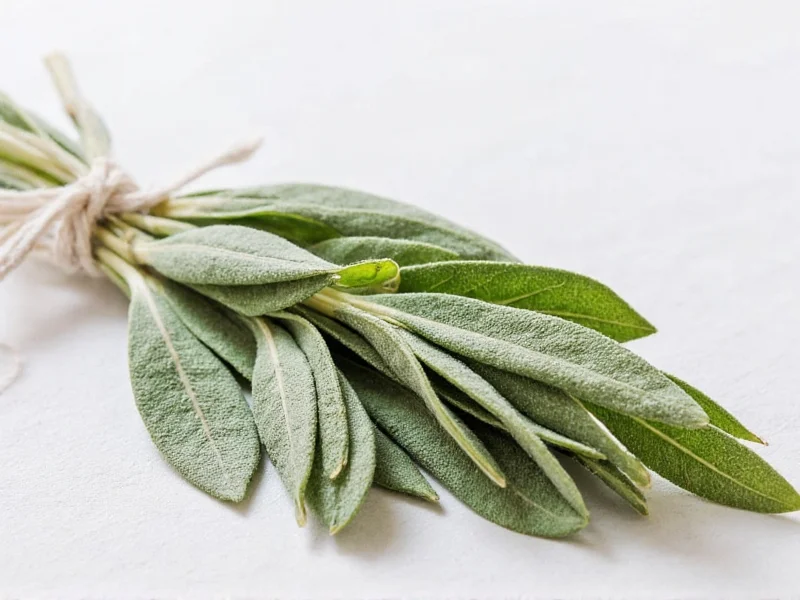The standard conversion ratio for sage is 1 part dried sage to 3 parts fresh sage. This means if a recipe calls for 1 tablespoon of fresh sage, you should use 1 teaspoon of dried sage instead. This 3:1 ratio accounts for the concentration of flavor that occurs during the drying process.
Understanding the proper sage fresh to dry conversion is essential for achieving balanced flavors in your cooking. Many home chefs struggle with herb substitutions, leading to dishes that are either under-seasoned or overwhelmingly herbal. The key difference lies in moisture content—fresh sage contains about 85% water, while dried sage has most of this removed, concentrating its essential oils and flavor compounds.
Why the 3:1 Sage Conversion Ratio Matters
When you're substituting dried sage for fresh in recipes, the concentration difference significantly impacts your final dish. Dried herbs generally have 2-3 times more concentrated flavor than their fresh counterparts because the drying process removes water while preserving the essential oils responsible for taste and aroma.
Using the wrong ratio can completely alter your dish's flavor profile. Too much dried sage creates a bitter, overpowering taste, while too little leaves your recipe lacking that distinctive earthy, slightly peppery note that makes sage so valuable in cooking.
Complete Sage Conversion Reference Chart
| Measurement | Fresh Sage | Dried Sage |
|---|---|---|
| Teaspoon | 3 tsp | 1 tsp |
| Tablespoon | 1 tbsp | 1 tsp |
| Cup | 1 cup | ⅓ cup |
| Ounce | 1 oz | ⅓ oz |
| Gram | 3 g | 1 g |
Flavor Profile Differences Between Fresh and Dried Sage
While the sage fresh to dry measurement conversion provides the technical substitution, understanding flavor differences ensures better culinary results. Fresh sage offers a brighter, more delicate flavor with subtle citrus notes and a softer aroma. Dried sage develops a more intense, earthy, and slightly camphorous character with pronounced peppery notes.
Professional chefs often adjust recipes beyond simple measurement conversion. For delicate dishes like custards or light sauces, they might use slightly less dried sage (a 4:1 ratio) to prevent bitterness. In robust recipes like sausage stuffing or hearty bean dishes, they sometimes increase the dried sage slightly (approaching a 2.5:1 ratio) to ensure the flavor holds up.
When to Use Each Form of Sage
Certain dishes benefit from specific sage forms. Understanding these nuances improves your cooking more than simple fresh sage to dried sage conversion ratio knowledge:
- Fresh sage shines in light pasta dishes, butter sauces, custards, and when used as a garnish where visual appeal matters
- Dried sage excels in long-cooked dishes like soups, stews, meatloaf, and sausage where its concentrated flavor can properly distribute
- Special technique: For dishes requiring quick cooking, reconstitute dried sage by soaking 1 teaspoon in 2 tablespoons warm water for 10 minutes before use
Storage Tips for Maximum Flavor Preservation
Proper storage affects your sage conversion accuracy because degraded herbs lose potency:
Fresh sage: Wrap leaves in slightly damp paper towels, place in airtight container, and refrigerate. Use within 7-10 days for optimal flavor. Freezing in olive oil preserves fresh sage flavor longer than drying.
Dried sage: Store in airtight glass container away from light and heat. Properly stored, it maintains peak potency for 6-12 months. After 12 months, you may need to increase the amount by 25% to achieve the same flavor intensity.
Common Sage Substitution Mistakes to Avoid
Even with the correct sage fresh to dry conversion, these errors undermine your results:
- Adding dried sage too late: Unlike fresh herbs, dried sage needs time to rehydrate and release flavors—add at least 20 minutes before dish completion
- Not adjusting for age: Older dried herbs lose potency—smell your sage; if aroma is weak, increase amount by 25-50%
- Ignoring recipe chemistry: In baking or delicate sauces, use ground dried sage for even distribution rather than rubbed leaves
- Over-processing: Crushing dried sage releases bitter compounds—rub gently between palms instead of grinding
Advanced Conversion Techniques for Professional Results
For truly precise cooking with fresh vs dried sage, consider these professional approaches:
When substituting in critical recipes, conduct a small test batch first. Mix your recipe base without sage, then prepare three versions: one with fresh sage at recipe amount, one with dried sage at standard 3:1 ratio, and one with dried sage at 2.5:1 ratio. Taste test to determine which ratio works best for your specific application and herb quality.
Remember that growing conditions, harvest time, and drying methods affect sage potency. Garden-fresh sage harvested in morning may require slightly different conversion than store-bought sage harvested weeks earlier.











 浙公网安备
33010002000092号
浙公网安备
33010002000092号 浙B2-20120091-4
浙B2-20120091-4